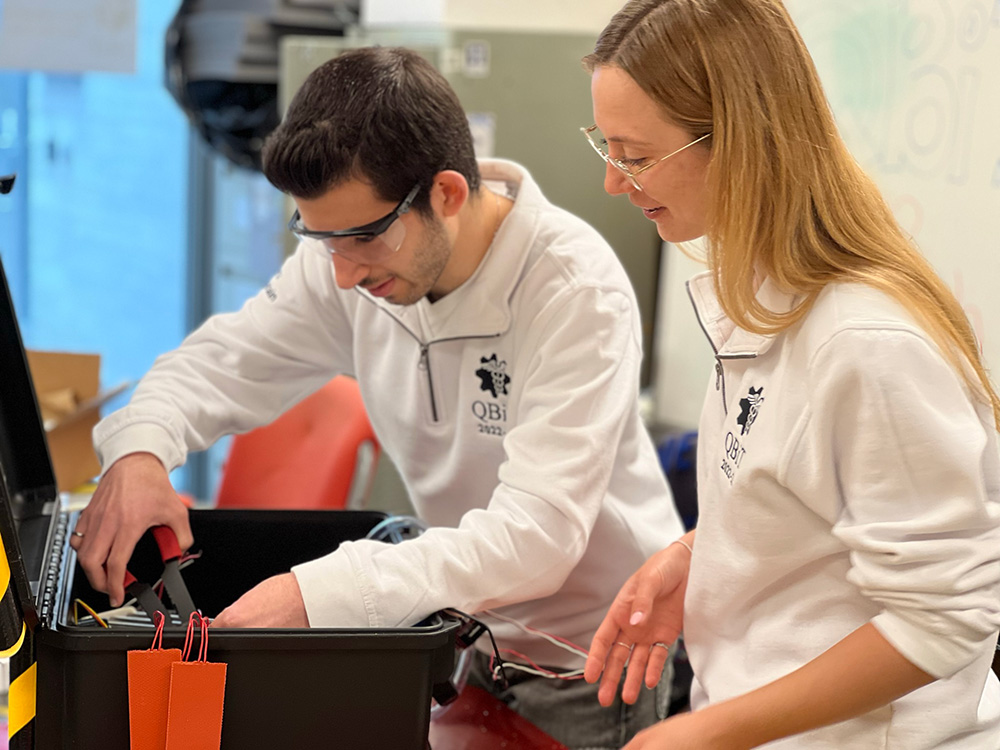Figure skating was always a big part of Julia Funk’s life. But so were the strains, tears, and brakes that often come with the sport. And when she got injured and had to reckon with rehab, she was always left wondering: “How is there nothing better out there for medical devices that might help me heal?”
Upon her arrival to Kingston and Queen’s Engineering in 2018, she learned of a student design team called the Queen’s Biomedical Innovation Team (QBiT). Launched just three years earlier, in 2015, it’s been hard at work, developing different biomedical products each year: a back brace for swimmers, and an app for mitigating concussion symptoms.
The lightbulb went off almost instantly for Funk. She joined the team in second year and started working on a special glove that would help alleviate hand spasticity in stroke victims. She loved it. “Honestly, without this design team, I probably wouldn’t be sure about what I want to do after I graduate,” she says. “But now I know I definitely want to pursue a career in this.”
Before embarking on that career, though, the biomechanical engineering student and now co-captain of QBiT has this year’s two projects to help finish. One is a special helmet that automatically inflates when it detects that a person is about to fall. The other is an ultraportable extracorporeal membrane oxygenation (ECMO) device that can temporarily sustain cardiac and lung functions.

Funk isn’t alone, of course. She has a co-captain, Daniel Kurtz, and the team includes a chief technical officer, chief financial officer, chief operating officer, and an outreach manager. There are also eight project managers and about 60 general members. All of them are from faculties across Queen’s, including engineering and health sciences.
Choosing which projects to tackle each year is usually up to the captains, says Kurtz, who is in his fourth year of biochemical engineering. “So this year Julia and I sat down, discussed, and looked into the recent scientific literature to see what’s out there. And one of the exciting things about the biomedical field is just the breadth of different technologies that we could be working on. This year’s projects are great examples of that.”
By mid-term, all the sub-teams had finished 3D-printing the individual parts for their projects. Next, they integrated all those parts, testing the projects, and then modifying them before hanging up their tools.
But they aren’t done. QBiT will take the ECMO device to the Rice360 Global Health Technology Challenge in Houston, Texas in late April. There they’ll present it alongside other student teams from around the world. The winners will be the teams that show the most innovation in addressing global health challenges in resource-limited settings. In addition, members of the team will travel to Vail, Colorado in early June for the poster competition at the Summer Biomechanics, Bioengineering, & Biotransport Conference
It will be a bittersweet send-off for Funk and Kurtz. Both are graduating this year and will soon pass the QBiT reins off to other captains.
For Kurtz, who will attend the University of Ottawa MD/PhD program after completing his degree at Queen’s, the research has been one of the greatest benefits of his experience with QBiT. “Research is a major part of how we figure out designs and really get these things working,” he says. “These projects are so far more advanced than what we do in the rest of our engineering curriculum, and so developing those research skills has been huge.”
Funk agrees, adding that working with such a diverse group of people has also been a big takeaway. “In Engineering, you tend to work on projects with a lot of the same people, but with QBiT I was exposed to so many different people at Queen’s from different backgrounds and faculties. It really was truly amazing to work alongside such a diverse group of people, and I’m just so grateful to have had this opportunity.”
